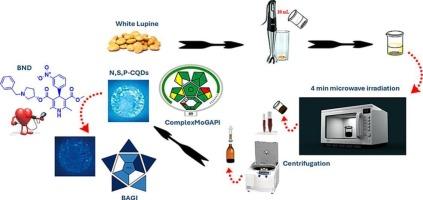利用羽扇豆碱衍生的多掺杂碳量子点检测巴尼地平的绿色荧光纳米传感器
IF 4.9
2区 化学
Q1 CHEMISTRY, ANALYTICAL
引用次数: 0
摘要
我们提出了一种基于氮、硫、磷共掺杂碳量子点(NSP-CQDs)的绿色荧光分析方法,用于选择性测定抗高血压药物巴尼地平。以白狼疮种子为前体,采用微波辅助快速合成CQDs,得到了高荧光纳米粒子,量子产率为25.2%。NSP-CQDs的最大发射波长为409 nm (λex = 320 nm), barnidipine通过内滤效应有效猝灭NSP-CQDs的荧光。该传感器在25.0 ~ 250.0 μM范围内具有良好的线性响应,检出限为4.91 μM,准确度高,平均回收率为99.81%。在灵敏度、选择性、精密度和准确度方面验证了分析性能,证实了该方法在药物制剂中的可靠性。采用复合修正GAPI和蓝色适用性等级指数(BAGI)指标对该方法的绿色度和实际可持续性进行了评估,强调其符合绿色分析化学原则。这项工作展示了将环保纳米材料整合到药物分析中,为基于荧光的药物测定提供了一种新颖、可靠、环保的可持续工具。本文章由计算机程序翻译,如有差异,请以英文原文为准。

Validated green fluorescent nanosensor for barnidipine determination using lupine-derived multi-doped carbon quantum dots
We present a green analytical fluorescence method for the selective determination of barnidipine, an antihypertensive drug, based on nitrogen, sulfur, and phosphorus co-doped carbon quantum dots (NSP-CQDs). The CQDs were synthesized via a rapid microwave-assisted approach using Lupinus albus seeds as a sustainable precursor, yielding highly fluorescent nanoparticles with a quantum yield of 25.2 %. The fluorescence of NSP-CQDs, with an emission maximum at 409 nm (λex = 320 nm), was efficiently quenched by barnidipine through an inner filter effect. The developed nanosensor enabled quantitative analysis of barnidipine with a linear response in the range of 25.0–250.0 μM, a detection limit of 4.91 μM, and high accuracy, achieving a mean recovery of 99.81 % in pharmaceutical dosage forms. Analytical performance was validated in terms of sensitivity, selectivity, precision, and accuracy, confirmed the reliability of the assay in pharmaceutical preparations. Greenness and practical sustainability of the method were assessed by Complex Modified GAPI and Blue Applicability Grade Index (BAGI) metrics, underscoring its compliance with green analytical chemistry principles. This work demonstrates the integration of eco-friendly nanomaterials into pharmaceutical analysis, providing a novel, reliable, and environmentally sustainable tool for fluorescence-based drug determination.
求助全文
通过发布文献求助,成功后即可免费获取论文全文。
去求助
来源期刊

Microchemical Journal
化学-分析化学
CiteScore
8.70
自引率
8.30%
发文量
1131
审稿时长
1.9 months
期刊介绍:
The Microchemical Journal is a peer reviewed journal devoted to all aspects and phases of analytical chemistry and chemical analysis. The Microchemical Journal publishes articles which are at the forefront of modern analytical chemistry and cover innovations in the techniques to the finest possible limits. This includes fundamental aspects, instrumentation, new developments, innovative and novel methods and applications including environmental and clinical field.
Traditional classical analytical methods such as spectrophotometry and titrimetry as well as established instrumentation methods such as flame and graphite furnace atomic absorption spectrometry, gas chromatography, and modified glassy or carbon electrode electrochemical methods will be considered, provided they show significant improvements and novelty compared to the established methods.
 求助内容:
求助内容: 应助结果提醒方式:
应助结果提醒方式:


